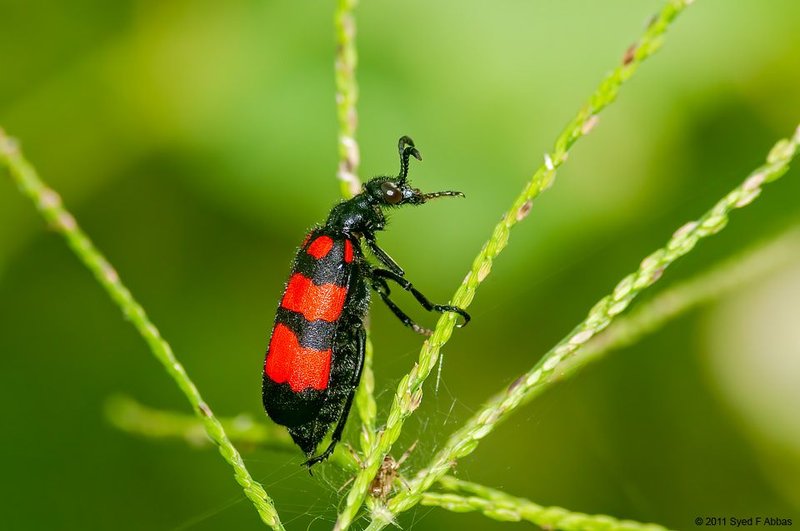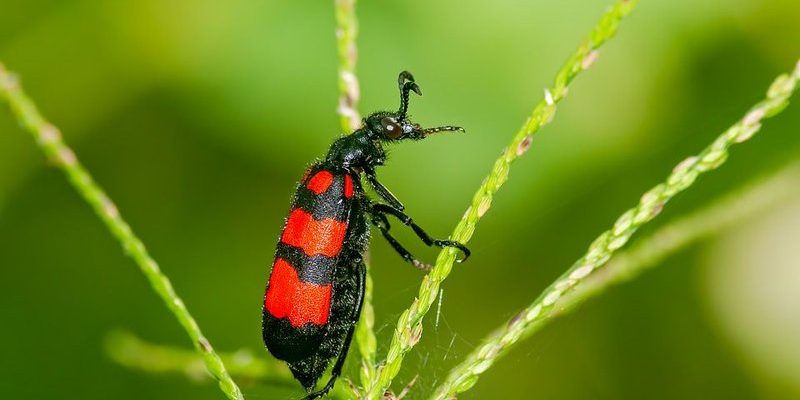
Blister beetles might not be the most familiar insects to you, but these critters are pretty remarkable. They belong to the family Meloidae and come in a variety of shapes and colors. You could say they’re the artists of the insect world! With their elongated bodies and striking hues, they can range from dull browns to vivid blues and yellows. Many of them sport unique markings that can leave you wondering how nature comes up with such creativity.
These beetles are most notable for their defense mechanism: they can produce a blistering chemical known as cantharidin. When threatened, a blister beetle can release this toxin, which can cause painful blisters on human skin and irritation to our mucous membranes. Imagine that! A tiny bug can pack such a punch. It’s a clever way of keeping predators at bay — they don’t want to find out what happens if they mess with one.
But there’s more to blister beetles than their defensive tactics. They also play a role in the ecosystem. While some species are known to harm crops, others are beneficial, helping to control pest populations. This dual nature makes them crucial players in the balance of nature but also a bit controversial among farmers and gardeners.
Physical Characteristics
Blister beetles come in various sizes, typically ranging from about 5 to 25 mm in length. Size can vary greatly depending on the species. Their bodies are usually elongated and soft, which is part of what makes them different from many other beetles. The colors? Oh, they can be a sight! You might find them in shades of gray, black, or even bright orange and yellow, often with striking patterns that make them stand out.
Their legs are long and designed for movement, allowing them to be surprisingly speedy for such small creatures. Take a second to appreciate the diversity here; some species can even have a more rounded shape, resembling something entirely different from your typical beetle. Their appearance is not just unique; it helps them with camouflage in their environments.
Another fascinating feature is their antennae, which are long and segmented, giving them an excellent sense of smell. You might say these little critters have a good nose for food and potential mates! Their wings, when present, allow for flight, though not all species fly well. This variability adds to their charm and makes spotting them even more exciting.
Life Cycle of Blister Beetles
The life cycle of a blister beetle is an intriguing journey that can captivate anyone who enjoys nature. Like many insects, blister beetles undergo a complete metamorphosis, which includes four stages: egg, larva, pupa, and adult. The entire life cycle typically takes a few months but can vary depending on the species and environmental conditions.
It all starts when the female lays her eggs in the soil or on plant leaves. The eggs hatch into larvae, which can be quite predatory in their early stages. These larvae, also known as “blister beetle larvae,” are often found lurking on flowers, waiting for unsuspecting prey, like grasshopper eggs or other insect larvae. It’s like watching a tiny version of a nature documentary unfold in your garden!
After several weeks of feeding, the larvae pupate, which is a stage similar to being in a cocoon. When they emerge as adults, they are ready to take on the world — or maybe just your backyard. Adult blister beetles are often found feeding on the foliage of plants, which can be detrimental to crops. However, their role as predator larvae helps maintain balance in the ecosystem.
Habitat and Distribution
Blister beetles can be found in a wide range of habitats, from fields and forests to gardens and grasslands. They thrive in sunny areas where their food sources, like flowers and foliage, abound. Typically, you’ll spot them on plants, especially in the warmer months when they are most active. Climate plays a significant role in their distribution; they tend to prefer regions with moderate to warm temperatures.
In the United States, you can find various species scattered across different states, though they are particularly common in the western regions. Some species have even adapted well to urban environments, making them more accessible for observation. Here’s the thing: blister beetles can be quite common but might go unnoticed due to their small size and knack for blending into their surroundings.
Interestingly, blister beetles are also known for their migratory behavior. They can travel significant distances in search of food or suitable breeding grounds. This makes them a fascinating subject for researchers who study insect patterns and habitats. If you’re hoping to see one, keep an eye on flowering plants during the summer months!
Diet and Feeding Habits
Feeding habits can vary significantly among blister beetle species. As larvae, they are often predatory, devouring other insects, especially soft-bodied ones like aphids and grasshopper eggs. You might say they’re the little hunters of the insect world. This behavior helps them grow and develop into healthy adults while also keeping pest populations in check. Talk about an eco-friendly pest control!
As adults, however, they switch gears and become herbivorous, primarily feeding on the leaves and flowers of plants. They seem to have a particular fondness for alfalfa and other legumes, which is why they can become pests for farmers. When you have a swarm of these beetles munching away, it can cause significant damage to crops, leaving farmers both frustrated and needing solutions.
Despite their harmful impact on agriculture, blister beetles play a crucial role in maintaining ecological balance. They tend to prefer flowers that are rich in nectar, which contributes to pollination efforts. As they go from flower to flower, they help plants reproduce, making their presence beneficial in the grand scheme of things, even if they can be pesky at times.
Threats and Conservation
While blister beetles are quite resilient, they face several threats from habitat destruction and climate change. As agricultural practices evolve and urban areas expand, their natural habitats may become fragmented, putting their populations at risk. Loss of habitat can hinder their feeding and breeding opportunities, which is vital for their survival.
Moreover, some farmers may resort to pesticides to protect their crops, inadvertently harming blister beetles and other beneficial insects. It’s a delicate balance: pest control is necessary for crop yields, but it can also lead to the decline of helpful species. This highlights the need for integrated pest management practices that consider the overall ecosystem rather than just one pest or another.
Conservation efforts are increasingly focusing on sustainable agricultural practices that protect beneficial insects. By promoting habitats that include wildflowers and fewer pesticides, we can help ensure that blister beetles and their kin continue to thrive. You might even get the chance to see them buzzing around your garden if you create a welcoming environment!
Interesting Facts About Blister Beetles
Blister beetles are full of surprises! Here are a few interesting tidbits to pique your curiosity:
- Cantharidin: This is the toxic chemical that blister beetles produce, and it’s potent enough to cause painful reactions in humans. However, some animals have adapted to tolerate it.
- Variety: There are over 2,500 species of blister beetles around the world, each with its unique characteristics and habitats.
- Predator or Pest? Depending on the stage of life and the species, they can be both beneficial (as larvae) and harmful (as adults) to crops.
- Color Changes: Some species can change color slightly based on their environment or the temperature, a fascinating adaptation!
- Mimicry: Certain blister beetles have evolved to mimic the appearance of more dangerous insects to deter predators.
| Category | Details |
| Size | 5 to 25 mm in length |
| Habitat | Fields, gardens, and grasslands |
| Diet | Predatory as larvae; herbivorous as adults |
| Life Span | Varies greatly; generally a few months |
| Color | Variety of colors, including brown, yellow, and blue |
FAQ
What do blister beetles look like?
Blister beetles vary greatly in appearance but generally have elongated bodies ranging from 5 to 25 mm in length. They can be found in various colors, often showcasing vibrant hues like yellow, orange, and even metallic blue, adorned with distinct patterns that add to their aesthetic appeal.
Are blister beetles harmful to humans?
Yes, blister beetles can be harmful to humans due to their ability to produce a chemical called cantharidin. This substance can cause painful blisters on skin and irritation to mucous membranes if contact occurs. However, they typically won’t attack unless provoked.
How do blister beetles contribute to the ecosystem?
Blister beetles play a dual role in the ecosystem. As larvae, they help control pest populations by feeding on insects like grasshopper eggs. As adults, they pollinate flowers while feeding on plants, contributing to plant reproduction.
Where can I find blister beetles?
You can find blister beetles in a variety of environments, including gardens, fields, and grasslands, especially during warmer months. They are typically found on flowering plants, where they feed and breed.
What should I do if I come in contact with a blister beetle?
If you come in contact with a blister beetle and experience skin irritation or the formation of blisters, wash the affected area with soap and water immediately. Applying a cool compress can help alleviate discomfort. If symptoms persist, consider consulting with a healthcare professional for further advice.
Can blister beetles fly?
Yes, blister beetles can fly. Not all species are strong fliers, but many possess wings that allow them to move around in search of food or mating opportunities. Their ability to fly helps them escape predators and find new habitats.
Are blister beetles endangered?
While many blister beetle species are not endangered, some populations may face threats due to habitat loss and the use of pesticides in agriculture. It’s important to monitor their habitat and implement sustainable practices to protect them and other beneficial insects.
How long do blister beetles live?
The lifespan of blister beetles varies, typically lasting a few months. Environmental conditions and specific species can affect their longevity. Generally, they live long enough to reproduce before the weather turns colder or food becomes scarce.
What plants do blister beetles prefer to eat?
Blister beetles primarily feed on the foliage of flowers and plants, especially preferring alfalfa and other legumes. They can also be found munching on various garden plants, making them a concern for farmers and gardeners alike.
What do I need to know about blister beetles and pets?
Blister beetles can be toxic to pets if ingested due to the cantharidin they produce. It’s important to keep an eye on your pets in areas where blister beetles are common, as some pets may be curious and try to eat them. If you suspect your pet has ingested a blister beetle, it’s best to contact your veterinarian immediately.

